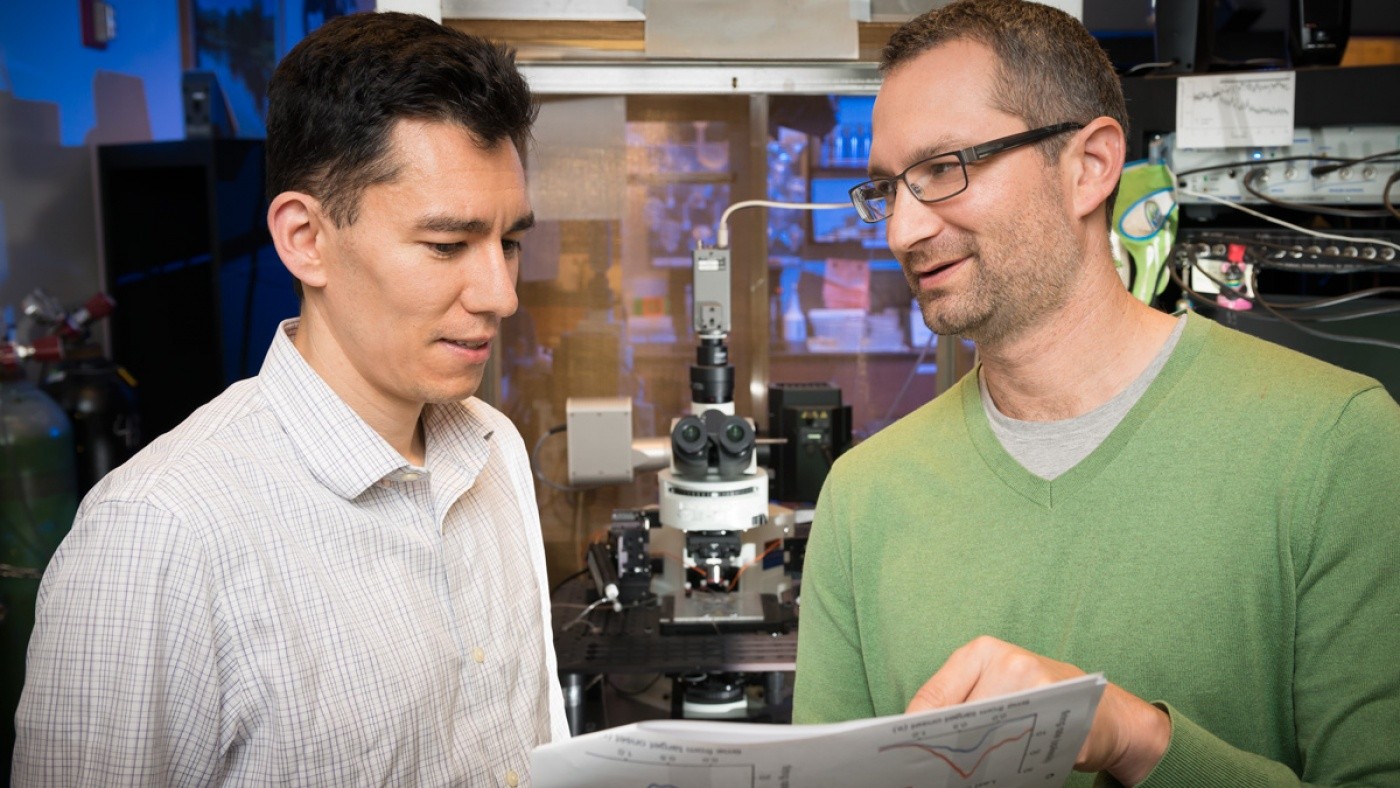Gladstone NOW: The Campaign Join Us on the Journey✕

Drs. Ken Nakamura and Anatol Kreitzer explore Parkinson’s disease from all angles—mapping its paths through the brain, linking its development to a loss of energy in neurons, and more. [Photo: Chris Goodfellow]
Affecting nearly 10 million people worldwide, Parkinson’s disease (PD) is among the most prevalent and destructive of all neurodegenerative conditions. Renowned Gladstone investigators Anatol Kreitzer, PhD, and Ken Nakamura, MD, PhD, are using basic scientific research to address PD head-on, making a series of critical new discoveries about the disease.
Kreitzer Maps Uncharted Brain Paths of PD
Dr. Kreitzer functions as a cartographer of sorts—mapping the path of PD’s course through the brain. He focuses on circuits in the striatum, an area of the brain that coordinates motor function. These circuits are compromised in PD patients, inhibiting their ability to control their movements.
While many in the field believe the circuits are primarily influenced by faulty signals from the brain’s cortex, Dr. Kreitzer has found that a little-studied part of the brain—the thalamus—may actually be a bigger culprit. In a mouse model of PD, he demonstrated that signals from the thalamus were significantly altered, whereas signal strength from the cortex remained relatively unchanged.
“For the first time, the thalamus has become a potential target area for PD,” says Dr. Kreitzer. “Going forward, my lab will explore whether current treatments, like L-dopa, can restore the circuit function of this area, or whether new and complementary therapeutic strategies are required.”
In another initiative related to L-dopa, Dr. Kreitzer is examining the relationship between the drug and dyskinesias, or involuntary muscle movements, experienced by long-term PD patients. Although L-dopa typically works well in alleviating PD symptoms early in the disease, many who take the drug for long periods develop dyskinesias, which can be as difficult and disruptive as the primary symptoms of PD.
By mapping the inputs and outputs of the neurons involved, Dr. Kreitzer has now identified a way to recapitulate these dyskinesias in experimental models—making them amenable to further study in his lab. Ultimately, his work promises to benefit the many patients who suffer from this major side effect of current PD treatments.
Nakamura Links Neuron Energy Loss to PD
Dr. Nakamura has made great strides in two initiatives that have substantially enhanced the understanding of PD. The first involves mitochondria—energy-generating structures inside of cells—and their critical role in the development of PD. Although recent research has shown that mitochondrial fission, the process by which mitochondria divide, is particularly important to the progression of neurodegenerative disorders such as PD and Alzheimer’s disease, the reason why has remained a mystery.
Dr. Nakamura has now created a mouse model of PD that has shed light on this process. In his model, he prevented dopamine neurons, which are highly susceptible to PD, from engaging in mitochondrial fission. His method revealed that the neurons require mitochondrial fission to transport mitochondria down long neuronal processes, called axons, that degenerate early in PD. The neurons also need this fission to maintain a healthy number of mitochondria overall.
“Our results suggest that alterations in mitochondrial fission and consequent energy failure, especially in axons, contribute to the death of dopamine neurons and development of PD,” Dr. Nakamura says. “Our ongoing studies aim to determine why some dopamine neurons can resist this disease process, in the hope of learning how to make vulnerable neuronal populations more resistant as well.”
Loss of energy also formed the basis of Dr. Nakamura’s second study, in which he has created the first definitive tests for detecting decreases in cellular energy levels—long believed to lead to the cell death that results in PD. The tests are especially valuable for their ability to measure energy levels at the synapse, the point at which a neuron passes signals to other neurons. While the synapse is an exceptionally difficult area to study, due to its very small size, it is also the first area to deteriorate in neurodegenerative diseases.
To develop his tests, Dr. Nakamura used a model of Leigh’s disease, another disorder that, like PD, involves mitochondria and affects the central nervous system. In this model, his tests succeeded in measuring both energy depletion in mitochondria and impaired synaptic vesicle release from neurons, a process that may consume more energy than any other. Dr. Nakamura is now using these proof-of-principle tests to study the impact of mutations in mitochondrial proteins that cause PD.
“Seeing patients helps me to think about the nature of movement disorders generally, not limited to PD, and this has enabled me to appreciate the great diversity of these diseases and the similarities and differences between them,” says Dr. Nakamura, who treats patients in addition to conducting basic science studies. “But most importantly, my clinical practice provides me with motivation for my lab work, reminding me of how PD research has the potential to improve the lives of so many.”
Young Scientists Committed to Finding Treatments for Neurodegenerative Diseases
Young Scientists Committed to Finding Treatments for Neurodegenerative Diseases
The 2020 Berkelhammer Scholars break new ground in research on dementias, Parkinson’s disease, and neuropsychiatric disorders
Donor Stories Parkinson’s Disease Alzheimer’s Disease Dementia Neurological Disease Akassoglou Lab Kreitzer Lab Mahley Lab Mucke Lab Nakamura LabNew Study Explains How Your Brain Helps You Learn New Skills
New Study Explains How Your Brain Helps You Learn New Skills
Gladstone scientists show how a type of neuron improves procedural learning
News Release Research (Publication) Neurological Disease Kreitzer LabProfile: Scott Owen, PhD
Profile: Scott Owen, PhD
Scott explains how his scientist parents worried he was too interested in science as a child. But that didn’t stop him from declaring he wanted to be a scientist as early as preschool.
Kreitzer Lab



